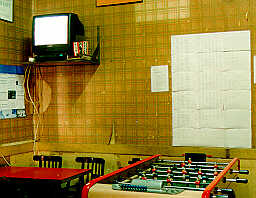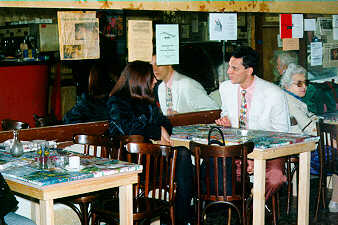
In the bar, called Wagram, hangs a 'tableau
de bord'. You will find all the c.v.'s of the paintings of Annie Abrahams
on it. The artist is behaving like an employee manager, or an official
of an unemployment office, who is making up an inventory and publicizes
the result .
The history of the origins of the 126 chaos pictures might be summed up
as follows: the investigation into 'truth' of the artist brought up the
following idea: ' chaos, seen as the simultaneous existence of different
truths is the only order'. The pictures are the tangible result of
this research process.
The paintings, once existing, had to have possibilities to live. Those
are multiple.
Existence always is time and place bound. One never can totally perceive
something whatsoever. Every situation knows different conditions for the
emerging of different qualities and properties .
Three tables at the Wagram are replaced by three others of exactly
the same size. 12 Pictures found a temporary place in three ensembles,
functioning as table-tops. The interest in art of the bar owner generated
3 mutants.
 The existence of a picture isn't restricted to its outward appearance or
its function. It can also manifest itself by means of derivatives.
The paintings of Annie Abrahams live a parallel life in her computer.
The video, shown in the Wagram, reveals the virtual
existence of the paintings in a succession of computer transformations.
The existence of a picture isn't restricted to its outward appearance or
its function. It can also manifest itself by means of derivatives.
The paintings of Annie Abrahams live a parallel life in her computer.
The video, shown in the Wagram, reveals the virtual
existence of the paintings in a succession of computer transformations.
The work of Annie Abrahams is functioning as a model to survive. In
this model, surviving means: adaptation to circumstances by way of new
combinations and alliances.
The tables where also used in 'meeting place'
in Nijmegen.



